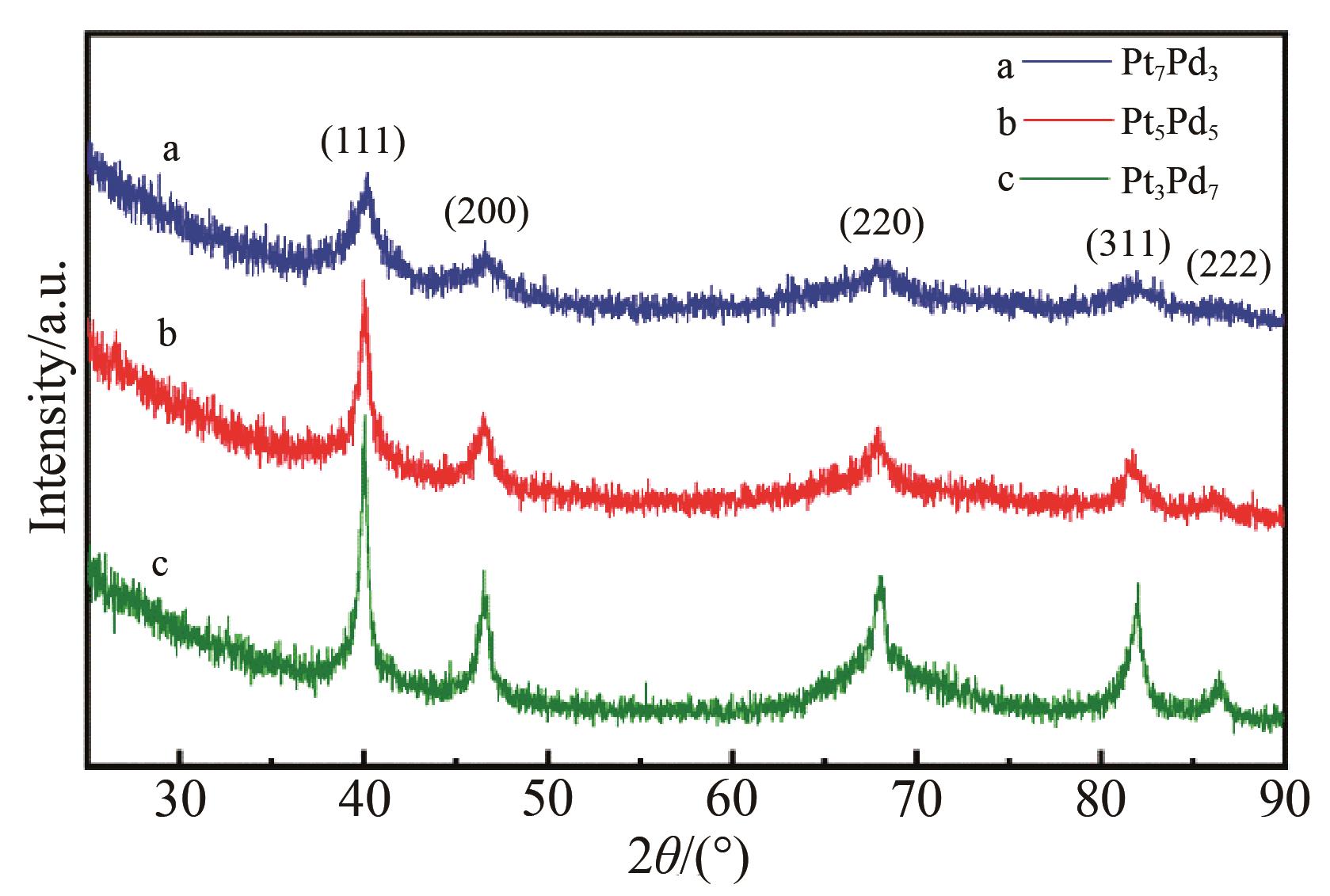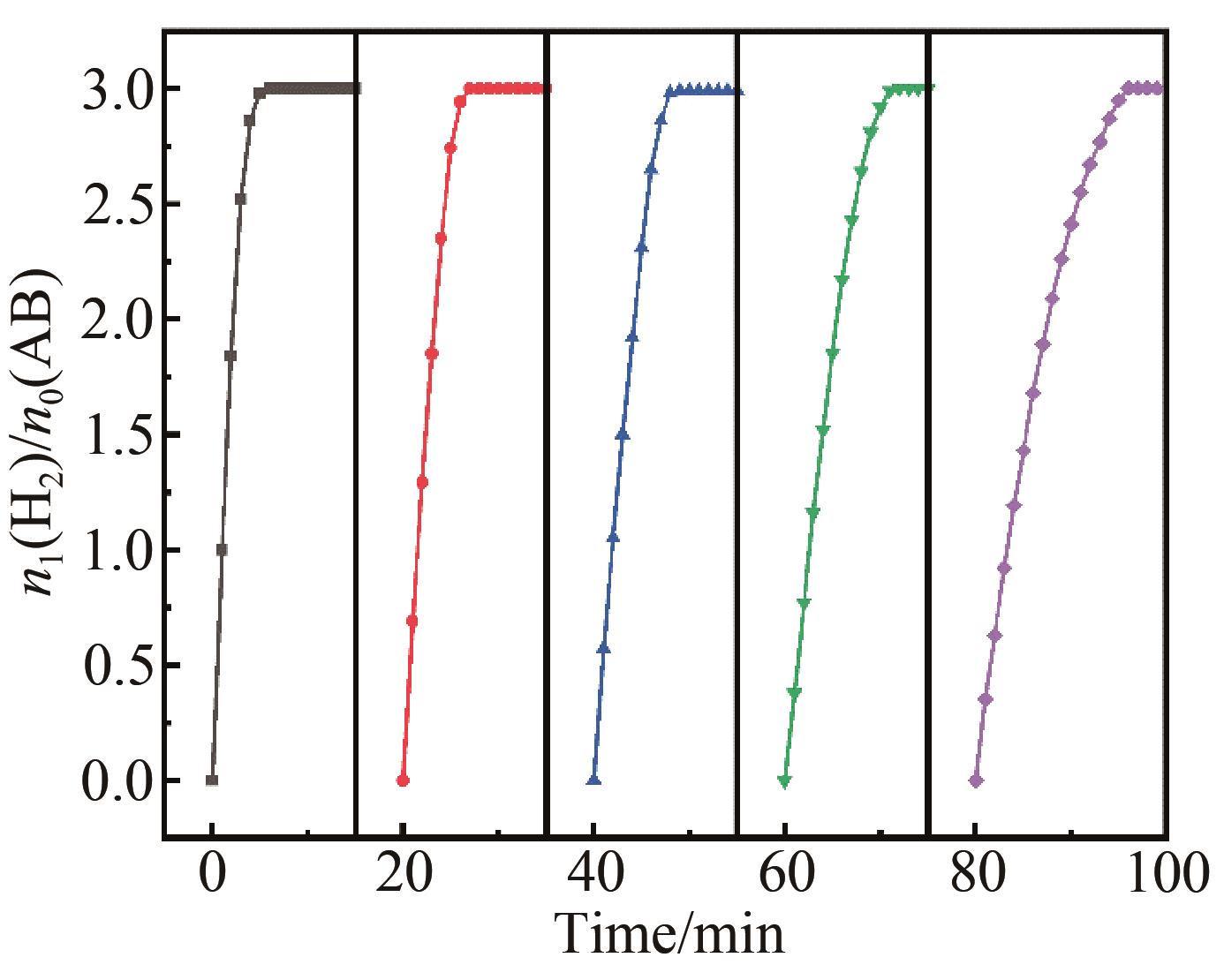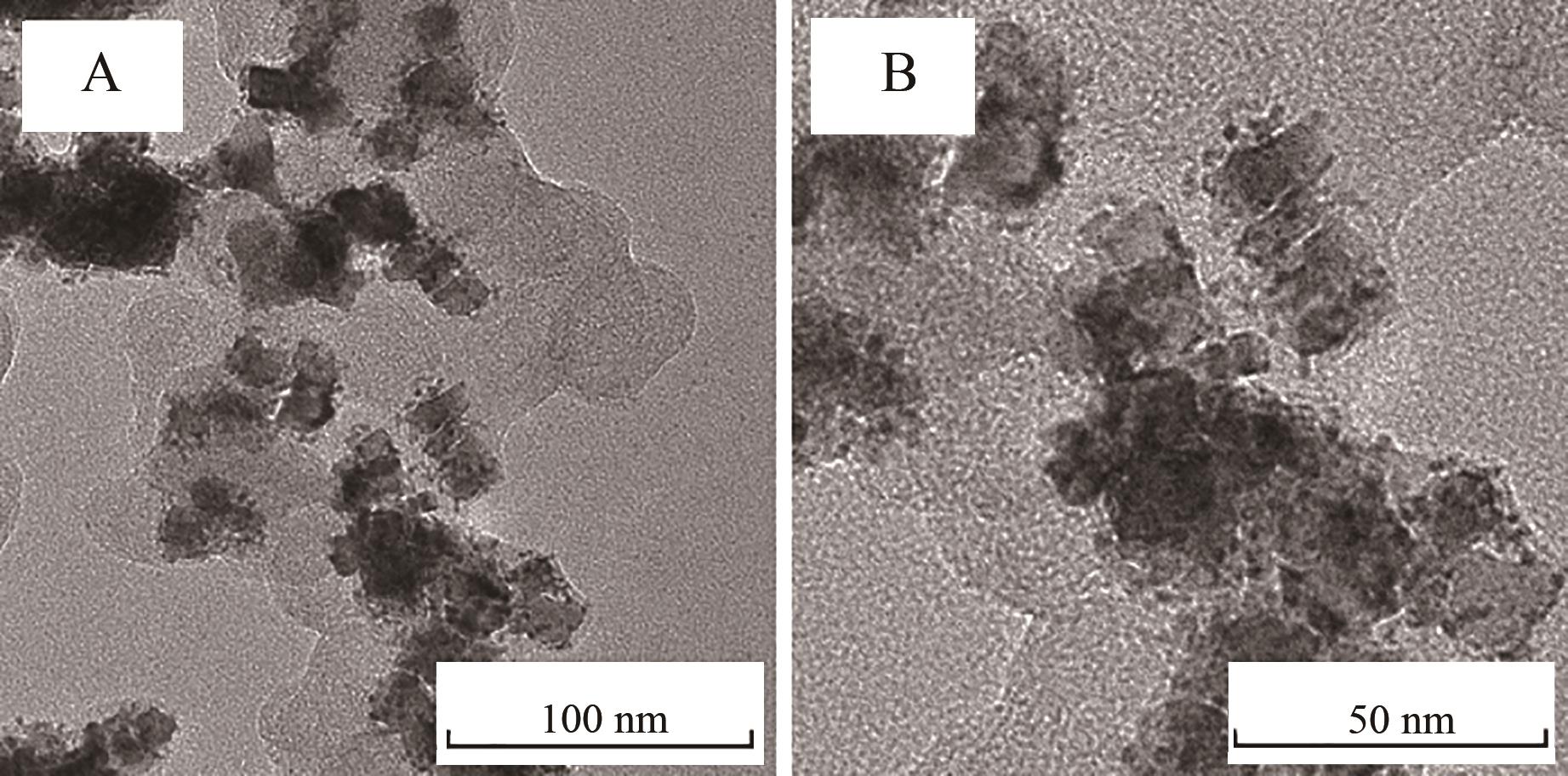
应用化学 ›› 2023, Vol. 40 ›› Issue (4): 597-609.DOI: 10.19894/j.issn.1000-0518.220321
离子液体调控合成Pt-Pd双金属纳米材料及其催化氨硼烷水解释氢
李慧慧, 姚开胜( ), 赵亚南, 范李娜, 田钰琳, 卢伟伟(
), 赵亚南, 范李娜, 田钰琳, 卢伟伟( )
)
- 河南科技大学化工与制药学院,洛阳 471023
-
收稿日期:2022-10-07接受日期:2023-02-22出版日期:2023-04-01发布日期:2023-04-17 -
通讯作者:姚开胜,卢伟伟 -
基金资助:国家自然科学基金(21673067);河南省科技攻关项目(192102210043)
Ionic Liquid-Modulated Synthesis of Pt-Pd Bimetallic Nanomaterials and Their Catalytic Performance for Ammonia Borane Hydrolysis to Generate Hydrogen
Hui-Hui LI, Kai-Sheng YAO( ), Ya-Nan ZHAO, Li-Na FAN, Yu-Lin TIAN, Wei-Wei LU(
), Ya-Nan ZHAO, Li-Na FAN, Yu-Lin TIAN, Wei-Wei LU( )
)
- Chemical Engineering & Pharmaceutics School,Henan University of Science & Technology,Luoyang 471023,China
-
Received:2022-10-07Accepted:2023-02-22Published:2023-04-01Online:2023-04-17 -
Contact:Kai-Sheng YAO,Wei-Wei LU -
About author:luwei1980@126.com
ksyao@haust.edu.cn
-
Supported by:the National Natural Science Foundation of China(21673067);the Key Science and Technology Project of Henan Province(192102210043)
摘要:
在离子液体溴化1-十四烷基-3-甲基咪唑([C14mim]Br)的调控下,以聚乙烯吡咯烷酮(PVP)为稳定剂,在90 ℃水溶液中一步制备出双金属Pt-Pd纳米材料。通过透射电子显微镜(TEM)、扫描电子显微镜(SEM)、高角度环形暗场扫描透射电镜(HAADF-STEM)、X射线能谱(EDS)、X射线衍射仪(XRD)和X射线光电子能谱(XPS)等对产物的形貌、结构、组成和价态等进行了详细的表征分析。结果表明,除了纯Pd样品,其它比例的Pt-Pd纳米材料均具有多孔结构。离子液体对多孔Pt-Pd纳米材料的调控起到了重要作用,对于[C n mim]Br离子液体,当烷基侧链长≥C12时,有利于形成多孔的Pd@Pt核壳球形结构。在氨硼烷水解释氢实验中,不同比例的Pt-Pd双金属纳米材料均表现出优于商用Pd/C的催化活性。其中,Pt3Pd7纳米材料具有最优的催化性能,催化过程在6 min内完成,产氢率高达100%。氨硼烷水解释氢的活化能(Ea)为36.15 kJ/mol,周转频率(TOF)为35.72 mol/(mol·min)。循环5次反应仅需51 min,产率仍能达到100%,表明该催化剂具有较高的催化活性和稳定性。
中图分类号:
引用本文
李慧慧, 姚开胜, 赵亚南, 范李娜, 田钰琳, 卢伟伟. 离子液体调控合成Pt-Pd双金属纳米材料及其催化氨硼烷水解释氢[J]. 应用化学, 2023, 40(4): 597-609.
Hui-Hui LI, Kai-Sheng YAO, Ya-Nan ZHAO, Li-Na FAN, Yu-Lin TIAN, Wei-Wei LU. Ionic Liquid-Modulated Synthesis of Pt-Pd Bimetallic Nanomaterials and Their Catalytic Performance for Ammonia Borane Hydrolysis to Generate Hydrogen[J]. Chinese Journal of Applied Chemistry, 2023, 40(4): 597-609.
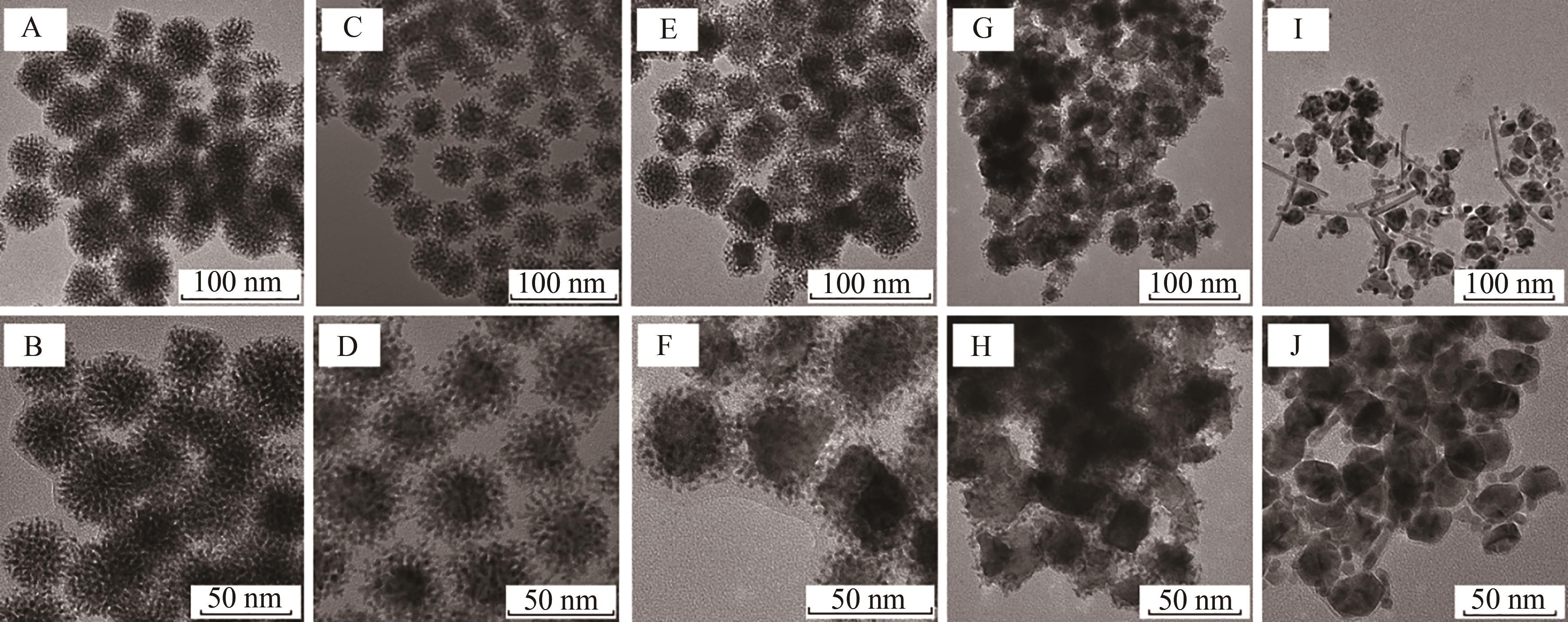
图1 不同摩尔比的n(Pt)∶n(Pd)样品在不同放大倍数下的TEM图A, B. 1∶0; C, D. 7∶3; E, F. 1∶1; G, H. 3∶7; I, J. 0∶1
Fig.1 TEM images of Pt-Pd samples with different Pt/Pd molar ratios
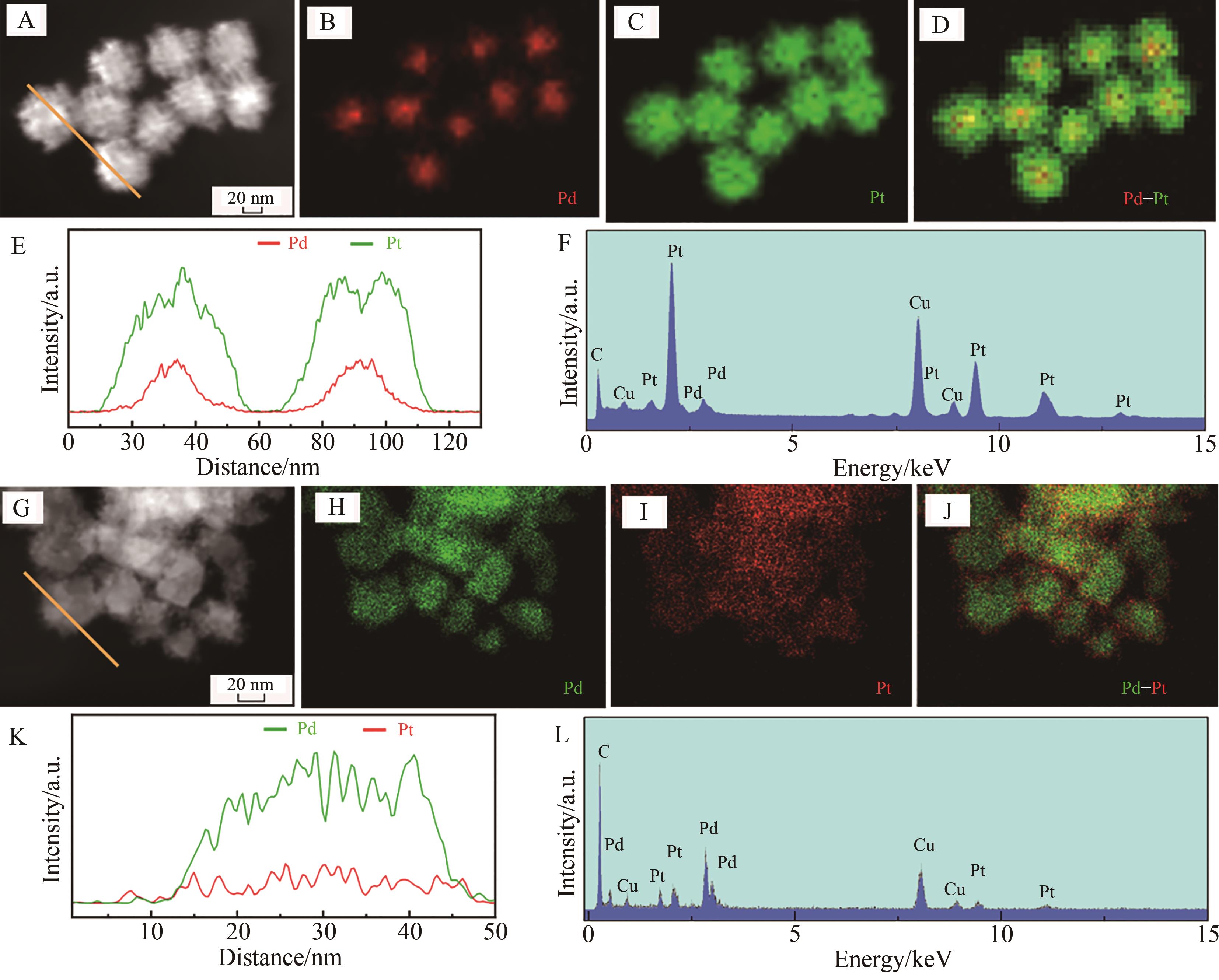
图2 所制备的Pt7Pd3样品和Pt3Pd7样品: Pt7Pd3样品的(A) HAADF-STEM图,(B-D)元素面扫图,(E)对应于(A)中橙线标记部分的元素线扫图和(F) EDS谱图;Pt3Pd7样品的(G) HAADF-STEM图,(H-J)元素面扫图,(K)对应于(G)中橙线标记部分的元素线扫图和(L) EDS谱图
Fig.2 The as-prepared Pt7Pd3 and Pt3Pd7 samples: (A) HAADF-STEM image, (B-D) elemental mapping images, (E) HAADF-STEM compositional curves of Pd (red lines) and Pt (green lines) along with the orange line in (A), (F) EDS spectra of Pt7Pd3 sample; (G) HAADF-STEM image, (H-J) elemental mapping images, (K) HAADF-STEM compositional curves of Pd (green lines) and Pt (red lines) along with the orange line in (G) and (L) EDS spectra of Pt3Pd7 sample
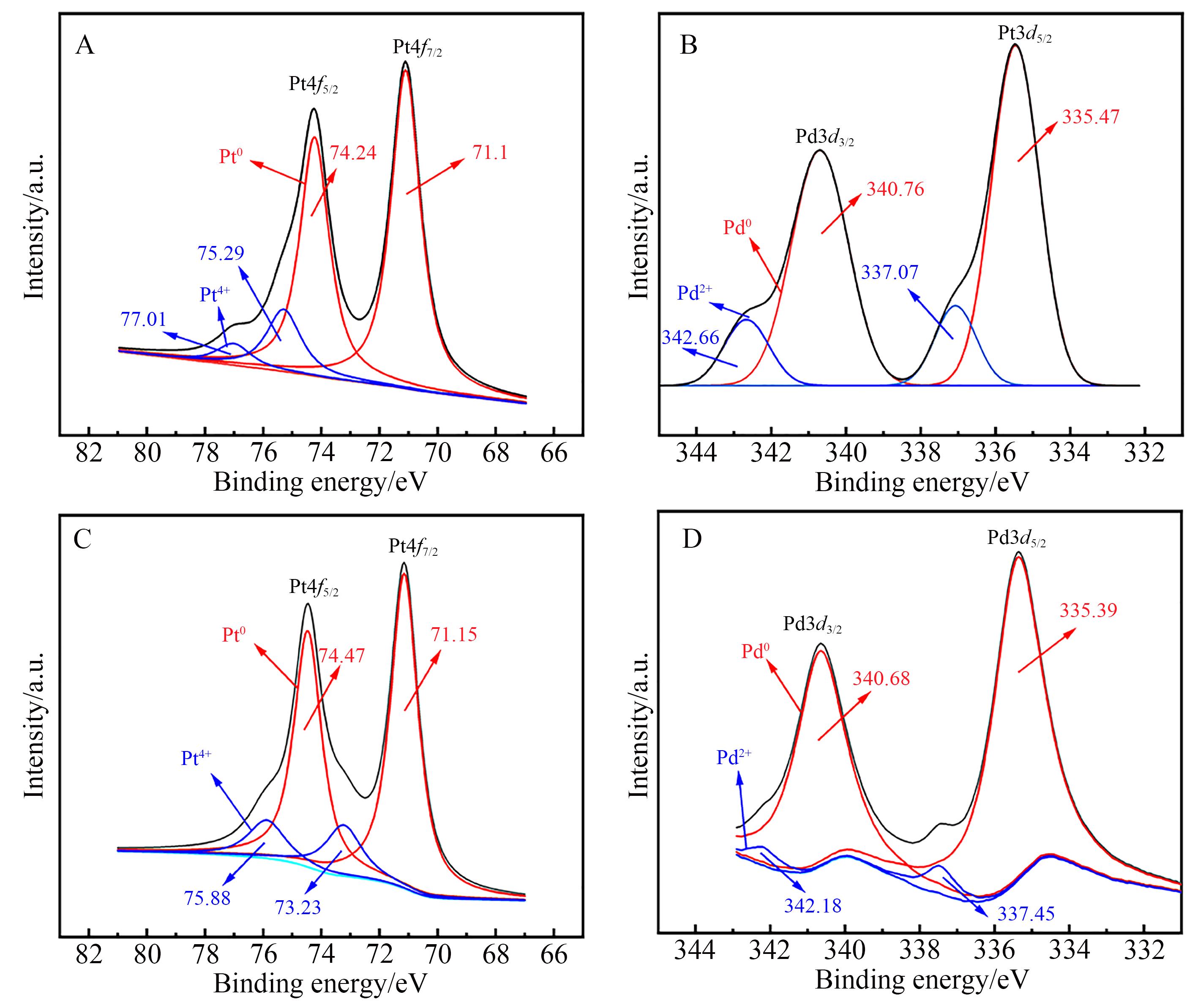
图 4 多孔Pt7Pd3样品(A、B)和Pt3Pd7样品(C、D)的Pt4f 和Pd3d 的高分辨XPS谱图
Fig.4 High-resolution XPS spectra of Pt4f and Pd3d for porous Pt7Pd3 sample (A, B) and Pt3Pd7 sample (C, D), respectively
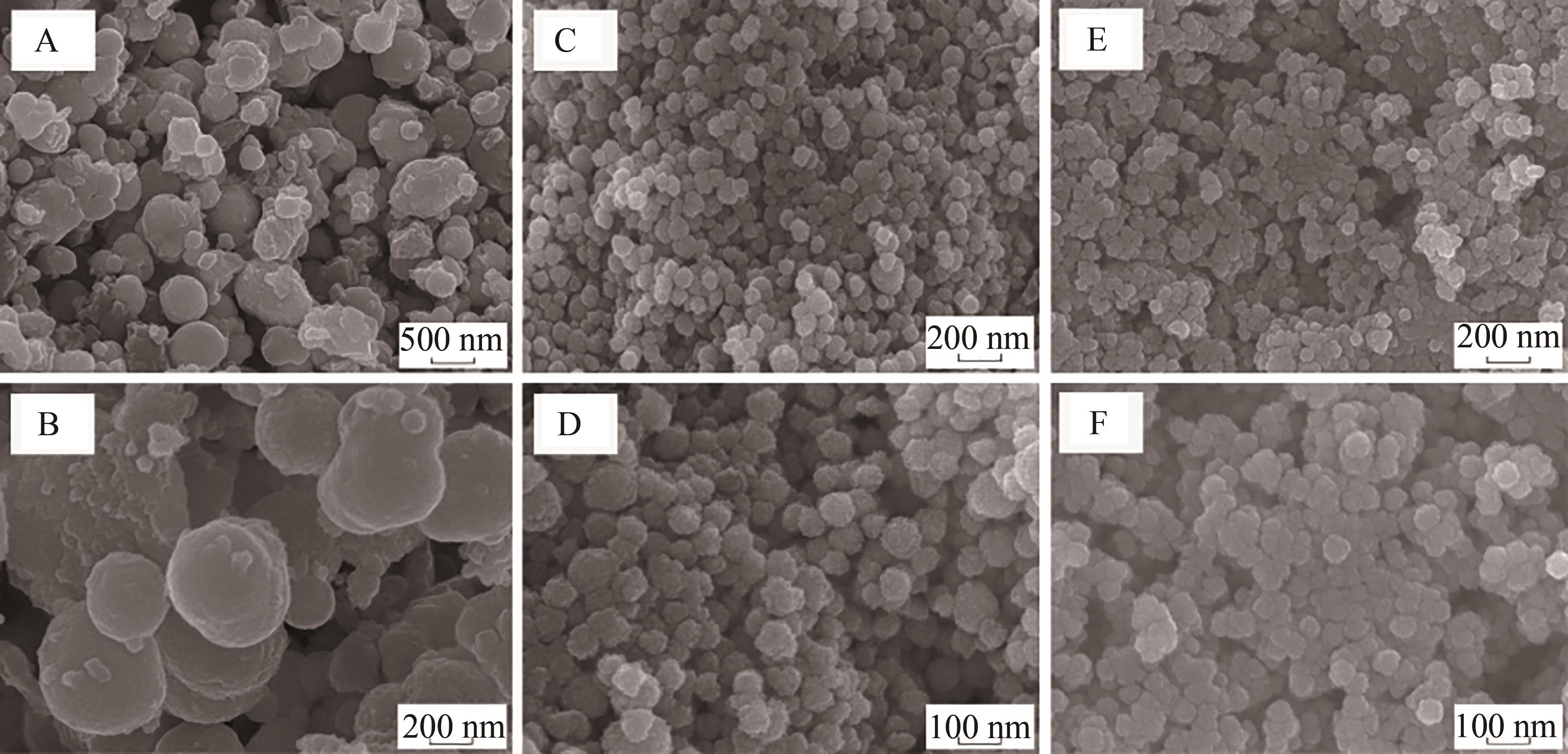
图5 在不同烷基链长存在下制备的Pt7Pd3样品的SEM图A, B. [C10mim]Br; C, D. [C12mim]Br; E, F. [C16mim]Br
Fig.5 SEM images of Pt7Pd3 samples prepared in the presence of ionic liquids with different alkyl chain lengths

图6 不同浓度[C14min]Br下制备的Pt7Pd3样品的TEM图c([C14min]Br)/(mmol·L-1): A. 75; B. 45; C. 35; D. 10
Fig.6 TEM images of Pt7Pd3 samples prepared in the presence of [C14min]Br with different concentrations
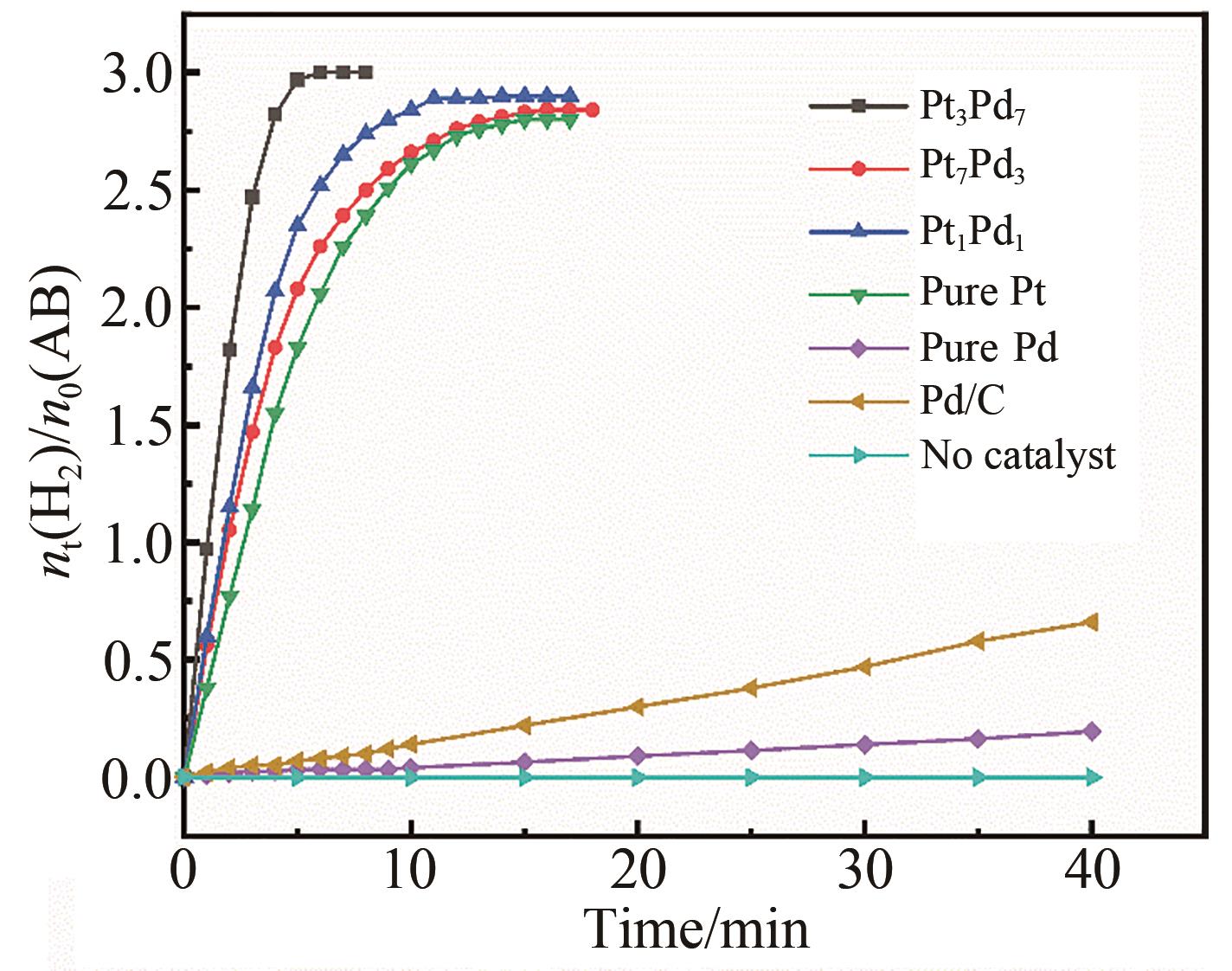
图7 25 ℃时不同催化剂催化AB水解生成H2的摩尔量随时间的变化曲线
Fig.7 The curves of equivalent H2 produced by per mole of AB hydrolysis in the presence of various catalysts as a function of reaction time at 25 ℃
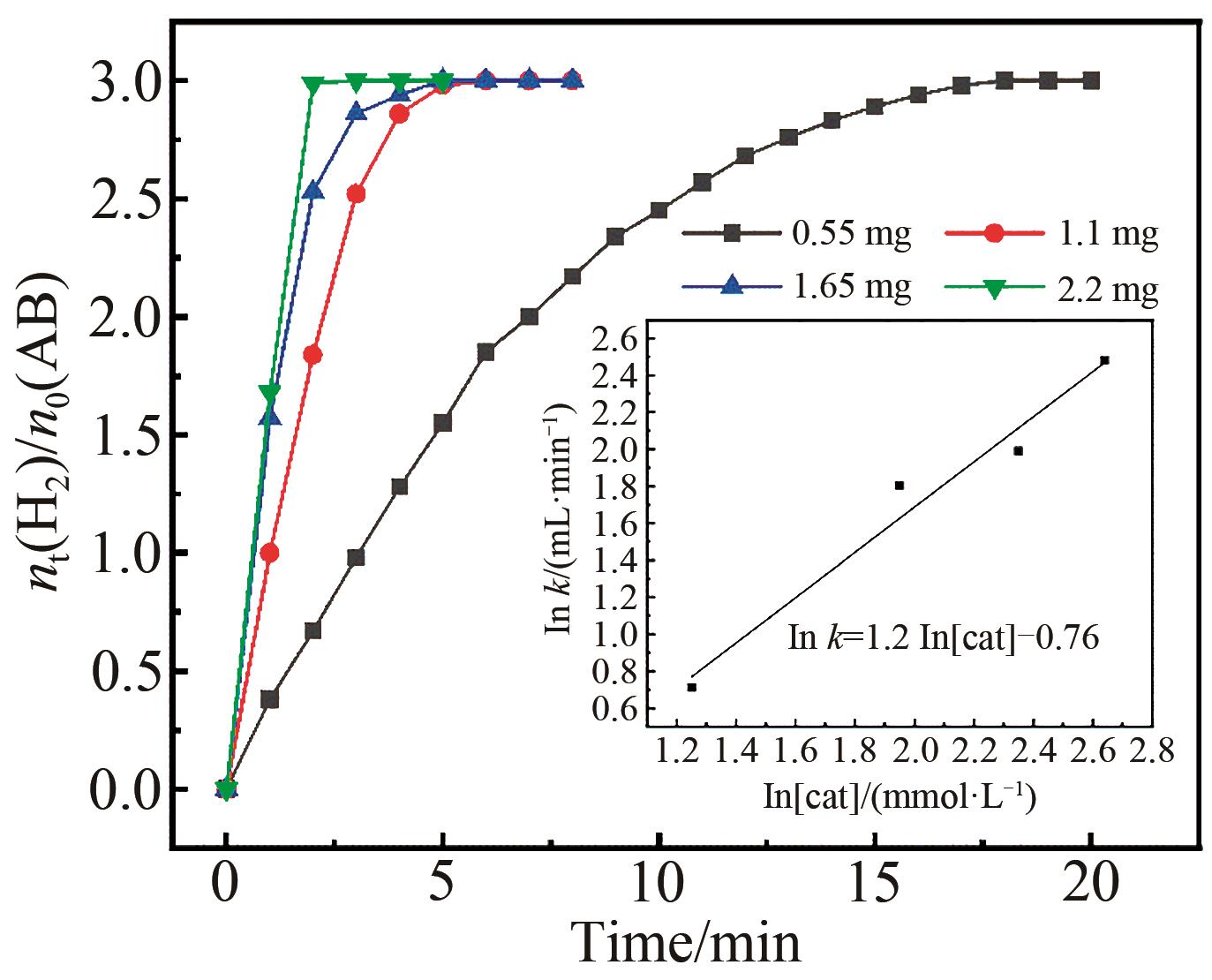
图8 不同Pt3Pd7催化剂量催化AB释放氢气量曲线;内插图:产氢速率与Pt3Pd7浓度的关系图(均为对数标度)
Fig.8 Plots of time versus hydrogen volume generated from AB catalyzed by Pt3Pd7 with different catalyst amounts; Inset: plot of hydrogen generation rate versus Pt3Pd7 concentration (both in logaritmic scale)
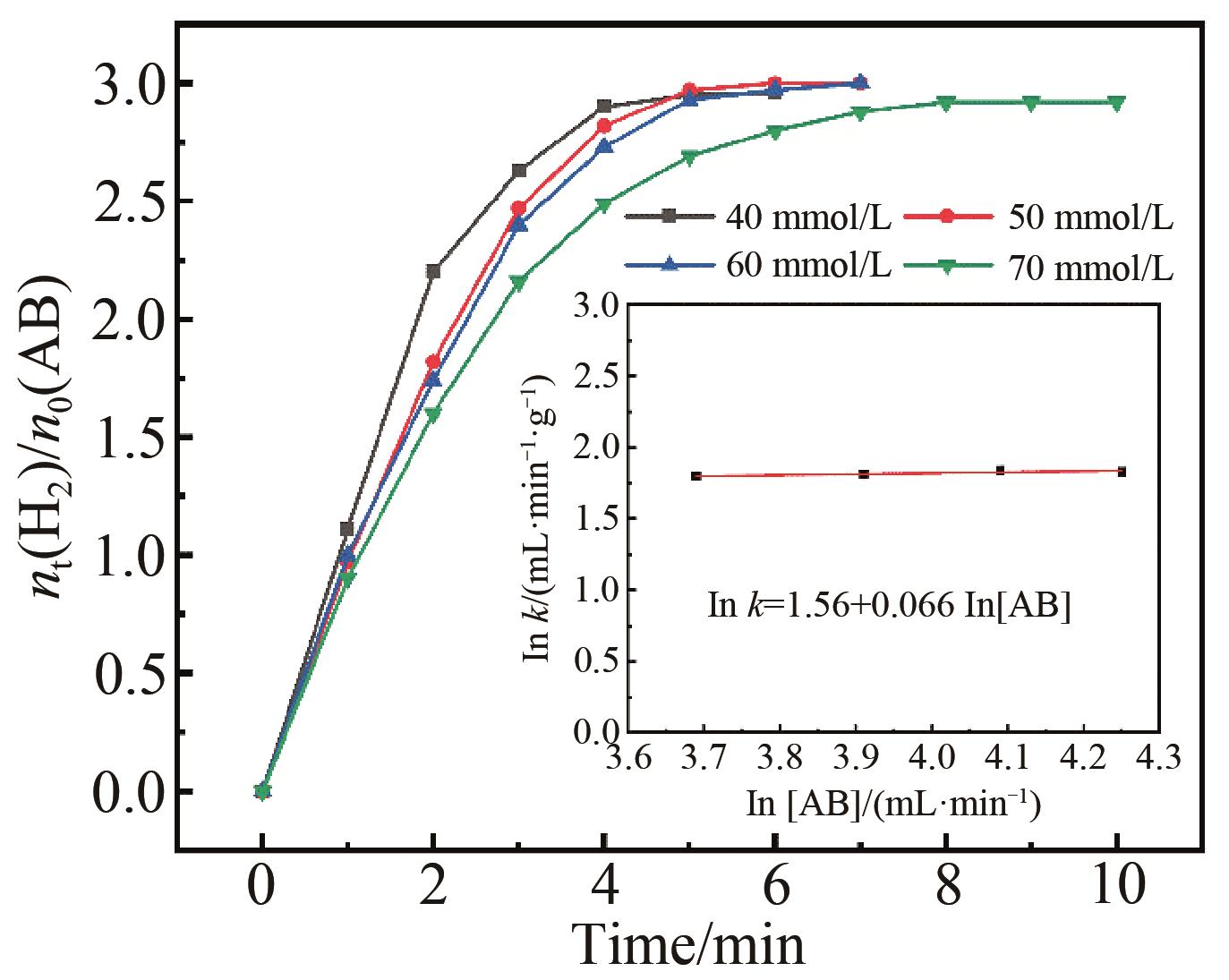
图9 Pt3Pd7催化剂浓度为7.0 mmol/L时,不同AB浓度(40、50、60、70 mmol/L)水解释放H2摩尔量随时间的变化图;插图:释氢速率与AB浓度的关系图(均采用对数标度)
Fig.9 Plots of moles of H2 versus time for the hydrolysis of AB at different concentrations (40,50,60,70 mmol/L) keeping Pt3Pd7 catalyst concentration at 7.0 mmol/L; Inset: plot of hydrogen generation rate versus AB concentration (both in logaritmic scale)
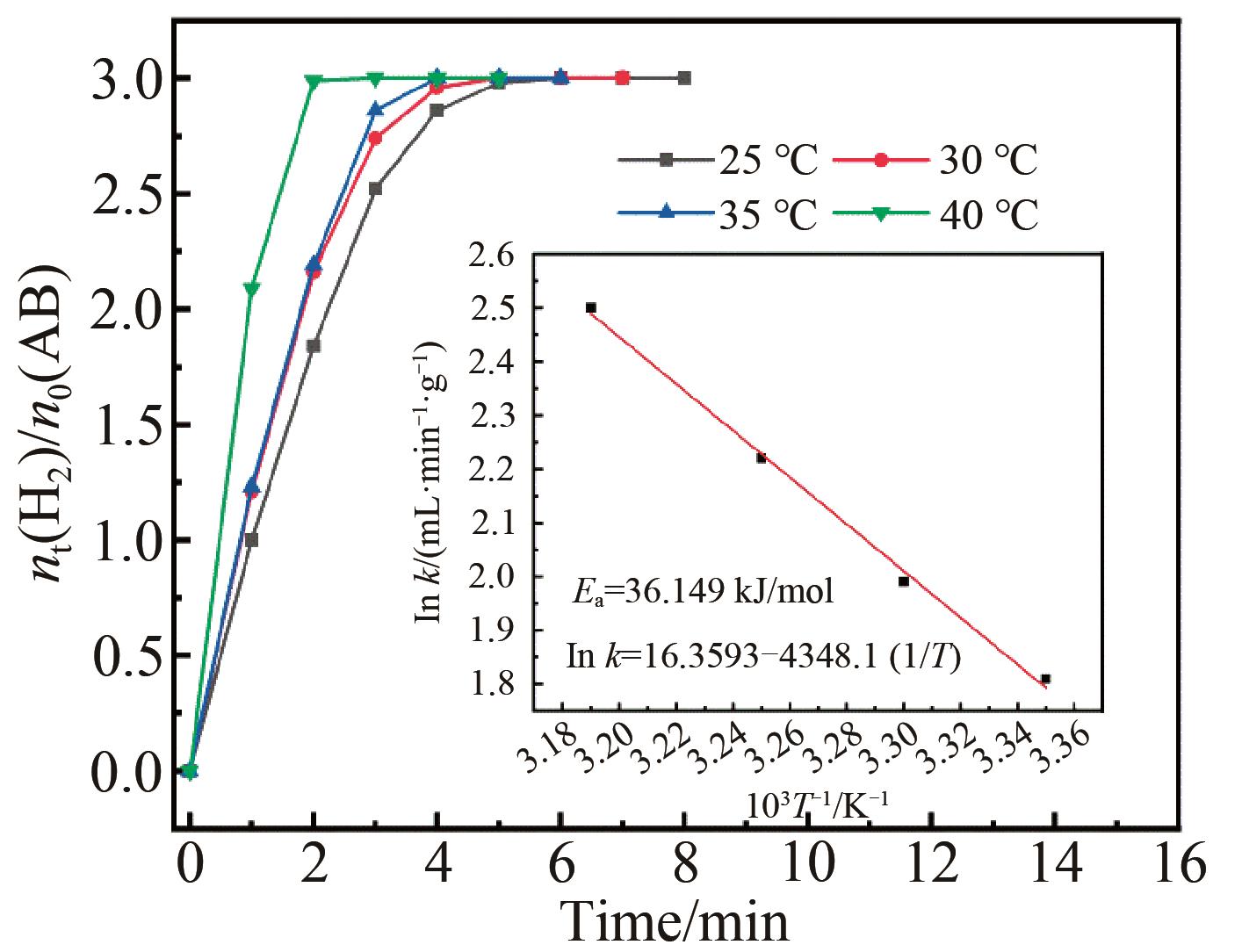
图10 多孔Pt3Pd7催化剂作用下,不同温度下每摩尔AB水解产生的等效H2随时间的变化图; 插图:依据阿伦尼乌斯方程拟合的ln k与1000/T的直线关系图
Fig.10 Plots of equivalent H2 produced by per mole of AB hydrolysis versus time in the presence of porous Pt3Pd7 catalyst at different temperature; Inset: the linear fitting of Arrhenius equation between ln k and 1000/T
| Catalysts | Temperature/℃ | TOF/(mol·mol-1·min-1) | Ea/(kJ·mol-1) | Ref. |
|---|---|---|---|---|
| Pt3Pd7 | 25 | 35.72 | 36.15 | This work |
| PdPt spherical NPs | 25 | 22.5 | 57.3 | [ |
| AuCo/CNT-2 | 25 | 8.47 | 34.83 | [ |
| Au@AuCo/CNT | 25 | 13.24 | 41.91 | [ |
| 1/1000Pt+Ni/CNT | 25 | 17.8 | - | [ |
| 1/100Pt+Ni/CNT | 25 | 33.3 | - | [ |
| Pd80Ni20-CeO2/rGO | 25 | 30.5 | - | [ |
| Ru1Co1/γ-Al2O3 | 65 | 32.9 | 47 | [ |
表 1 不同催化剂催化AB水解释氢反应的Ea和TOF值
Table 1 TOF and Ea values for AB hydrolysis to produce hydrogen with different catalysts
| Catalysts | Temperature/℃ | TOF/(mol·mol-1·min-1) | Ea/(kJ·mol-1) | Ref. |
|---|---|---|---|---|
| Pt3Pd7 | 25 | 35.72 | 36.15 | This work |
| PdPt spherical NPs | 25 | 22.5 | 57.3 | [ |
| AuCo/CNT-2 | 25 | 8.47 | 34.83 | [ |
| Au@AuCo/CNT | 25 | 13.24 | 41.91 | [ |
| 1/1000Pt+Ni/CNT | 25 | 17.8 | - | [ |
| 1/100Pt+Ni/CNT | 25 | 33.3 | - | [ |
| Pd80Ni20-CeO2/rGO | 25 | 30.5 | - | [ |
| Ru1Co1/γ-Al2O3 | 65 | 32.9 | 47 | [ |
| 1 | ZHAN W W, ZHU Q L, XU Q. Dehydrogenation of ammonia borane by metal nanoparticle catalysts[J]. ACS Catal, 2016, 6(10): 6892-6905. |
| 2 | 刘林昌, 郭亚君, 朱红林, 等. 负载型超细纳米材料催化氨硼烷水解制氢的研究进展[J]. 应用化学, 2021, 38(11): 1405-1422. |
| LIU L C, GUO Y J, ZHU H L, et al. Research progress on supported ultrafine nano-catalysts for hydrolytic dehydrogenation of ammonia borane[J]. Chin J Appl Chem, 2021, 38(11): 1405-1422. | |
| 3 | MBOYI C D, POINSOT D, ROGER J, et al. The hydrogen-storage challenge: nanoparticles for metal-catalyzed ammonia borane dehydrogenation[J]. Small, 2021, 17: 2102759. |
| 4 | HE T, PACHFULE P, WU H, et al. Hydrogen carriers[J]. Nat Rev Mater, 2016, 1: 16059. |
| 5 | WEN M C, CUI Y W, KUWAHARA Y, et al. Non-noble-metal nanoparticle supported on metal-organic framework as an efficient and durable catalyst for promoting H2 production from ammonia borane under visible light irradiation[J]. ACS Appl Mater Interfaces, 2016, 8: 21278-21284. |
| 6 | ZHANG J K, CHEN C Q, YAN W J, et al. Ni nanoparticles supported on CNTs with excellent activity produced by atomic layer deposition for hydrogen generation from the hydrolysis of ammonia borane[J]. Catal Sci Technol, 2017, 7: 322-329. |
| 7 | ZOU H, JIN B, WANG R W, et al. Iodide-mediated templating synthesis of highly porous rhodium nanospheres for enhanced dehydrogenation of ammonia borane[J]. J Mater Chem A, 2018, 6(47): 24166-24174. |
| 8 | ÖZHAVA D, KILIÇASLAN N Z, ÖZKAR S. PVP-stabilized nickel(o) nanoparticles as catalyst in hydrogen generation from the methanolysis of hydrazine borane or ammonia borane[J]. Appl Catal B: Environ, 2015, 162: 573-582. |
| 9 | HU H W, XIN J H, HU H, et al. Synthesis and stabilization of metal nanocatalysts for reduction reactions-a review[J]. J Mater Chem A, 2015, 3(21): 11157-11182. |
| 10 | YAN Y C, DU J S, GILROY K D, et al. Intermetallic nanocrystals: syntheses and catalytic applications[J]. Adv Mater, 2017, 29(14): 1605997. |
| 11 | HONG W, WANG J, WANG E K. Facile synthesis of highly active PdAu nanowire networks as self-supported electrocatalyst for ethanol electrooxidation[J]. ACS Appl Mater Interfaces, 2014, 6(12): 9481-9487. |
| 12 | ZHANG J, LI H B, ZHANG H, et al. Porously hierarchical Cu@Ni cubic-cage microstructure: very active and durable catalyst for hydrolytically liberating H2 gas from ammonia borane[J]. Renew Energy, 2016, 99: 1038-1045. |
| 13 | JIANG B, LI C, ÖMER D, et al. Mesoporous metallic rhodium nanoparticles[J]. Nat Commun, 2017, 8: 15581. |
| 14 | LAMY C. Electrocatalytic oxidation of organic compounds on noble metals in aqueous solution[J]. Electrochim Acta, 1984, 29(11): 1581-1588. |
| 15 | ZHANG H, JIN M, XIA Y. Enhancing the catalytic and electrocatalytic properties of Pt-based catalysts by forming bimetallic nanocrystals with Pd[J]. Chem Soc Rev, 2012, 41(24): 8035-8049. |
| 16 | YIN A X, MIN X Q, ZHANG Y W, et al. Shape-selective synthesis and facet-dependent enhanced electrocatalytic activity and durability of monodisperse sub-10 nm Pt-Pd tetrahedrons and cubes[J]. J Am Chem Soc, 2011, 133(11): 3816-3819. |
| 17 | ARLIN J A, KENGO A, TAKEYUKI U, et al. PdPt Nanocubes: a high-performance catalyst for hydrolytic dehydrogenation of ammonia borane[J]. Part Part Syst Char, 2013, 30(10): 888. |
| 18 | DINSMORE A D, HSU M F, NIKOLAIDES M G, et al. Colloidosomes: selectively permeable capsules composed of colloidal particles[J]. Science, 2002, 298(5595): 1006-1009. |
| 19 | BERTHOD A, RUIZ-ÁNGEL M J, CARDA-BROCH S. Recent advances on ionic liquid uses in separation techniques[J]. J Chromatogr A, 2018, 1559: 2-16. |
| 20 | NASIR R, MOHSHIM D F, MANNAN H A, et al. A perspective on ionic liquid-based membranes for CO2 separation[J]. Chem Pap, 2021, 75(3): 839-852. |
| 21 | CORREIA D M, FERNANDES L C, MARTINS P M, et al. Ionic liquid-polymer composites: a new platform for multifunctional applications[J]. Adv Funct Mater, 2020, 30: 1909736. |
| 22 | ZHAO Y, ZHAO Y, QIU J, et al. Facile grafting of imidazolium salt in covalent organic frameworks with enhanced catalytic activity for CO2 fixation and the knoevenagel reaction[J]. ACS Sustainable Chem Eng, 2020, 8: 18413-18419. |
| 23 | LI Z, SHI Y, ZHU A, et al. Light-responsive, reversible emulsification and demulsification of oil-in-water pickering emulsions for catalysis[J]. Angew Chem Int Ed, 2021, 60: 3928-3933. |
| 24 | ZHANG G R, ETZOLD B J M. Emerging applications of solid catalysts with ionic liquid layer concept in electrocatalysis[J]. Adv Funct Mater, 2021, 31: 2010977. |
| 25 | VENTURA S P M, SILVA F A E, QUENTAL M V, et al. Ionic-liquid-mediated extraction and separation processes for bioactive compounds: past, present, and future trends[J]. Chem Rev, 2017, 117: 6984-7052. |
| 26 | WANG H, CUI J, ZHAO Y, et al. Highly efficient separation of 5-hydroxymethylfurfural from imidazolium-based ionic liquids[J]. Green Chem, 2021, 23: 405-411. |
| 27 | LI Z, FENG Y, LIU X, et al. Light triggered switchable ionic liquid aqueous two-phase systems[J]. ACS Sustainable Chem Eng, 2020, 8: 15327-15335. |
| 28 | ZHANG T, DOERT T, WANG H, et al. Inorganic synthesis based on reactions of ionic liquids and deep eutectic solvents[J]. Angew Chem Int Ed, 2021, 60: 22148-22165. |
| 29 | SEITKALIEVA M M, SAMOYLENKO D E, LOTSMAN K A, et al. Metal nanoparticles in ionic liquids: synthesis and catalytic applications[J]. Coordin Chem Rev, 2021, 445: 213982. |
| 30 | YAO K S, WANG N, LI Z Y, et al. Ionic liquid-modulated synthesis of porous worm-like gold with strong SERS response and superior catalytic activities[J]. Nanomaterials, 2019, 9: 1772. |
| 31 | 王楠, 姚开胜, 赵晨晨, 等. 离子液体辅助合成AuPd纳米海绵及催化性能[J]. 高等学校化学学报, 2020, 41(1): 62-69. |
| WANG N, YAO K S, ZHAO C C, et al. Ionnic liquid-assisted synthesis of AuPd nanosponges and their catalytic performance[J]. Chem J Chin Univ, 2020, 41(1): 62-69. | |
| 32 | YAO K S, LI T J, ZHAO C C, et al. Au3Pd1 nanodendrites with hyperbranched architectures: green synthesis at room temperature and highly selective hydrogenation for 4-nitrophenylacetylene[J]. ACS Sustainable Chem Eng, 2020, 8: 14914-14926. |
| 33 | 李旺. 类沸石咪唑酯骨架材料-8的形貌调控及其催化制氢性能[J]. 应用化学, 2022, 39(7): 1065-1072. LI W. Morphology control and catalytic dehydrogenation performance of zeolitic imidazolate frameworks-8[J]. Chin J Appl Chem, 2022, 39(7): 1065-1072. |
| 34 | WANG L, YAMAUCHI Y. Metallic nanocages: synthesis of bimetallic Pt-Pd hollow nanoparticles with dendritic shells by selective chemical etching[J] . J Am Chem Soc, 2013, 135(45): 16762-16765. |
| 35 | YAO K S, ZHAO C C, WANG N, et al. An aqueous synthesis of porous PtPd nanoparticles with reversed bimetallic structures for highly efficient hydrogen generation from ammonia borane hydrolysis[J]. Nanoscale, 2020, 125(2): 638-647. |
| 36 | 王晓俊, 许文, 刘润路, 等. 水凝胶负载的纳米银/氮化碳光催化剂的制备及性能研究[J]. 无机材料学报,2022, 37(7): 731-740. |
| WANG X J, XU W, LIU R L, et al. Preparation and properties of Ag@C3N4 photocatalyst supported by hydrogel[J]. J Inoge Mater, 2022, 37(7): 731-740. | |
| 37 | GOODCHILD I, COLLIER L, MILLAR S L, et al. Structural studies of the phase, aggregation and surface behaviour of 1-alkyl-3-methylimidazolium halide+water mixtures[J]. J Colloid Interface Sci, 2007, 307(2): 455-468. |
| 38 | BLESIC M, MARQUES M H, PLECHKOVA N V, et al. Self-aggregation of ionic liquids: micelle formation in aqueous solution[J]. Green Chem, 2007, 9: 481-490. |
| 39 | BHARGAVA B L, KLEIN M L. Formation of micelles in aqueous solutions of a room temperature ionic liquid: a study using coarse grained molecular dynamics[J]. Soft Matter, 2009, 107(4/5/6): 393-401. |
| 40 | SHI L, WEI Y, SUN N, et al. First observation of rich lamellar structures formed by a single-tailed amphiphilic ionic liquid in aqueous solutions[J]. Chem Commun, 2013, 49: 113880-11390. |
| 41 | XU Q, CHANDRA M J. Catalytic activities of non-noble metals for hydrogen generation from aqueous ammonia-borane at room temperature[J]. J Power Sources, 2006, 163(1): 364-370. |
| 42 | ZHOU Q, XU C. Nanoporous PtRu alloys with unique catalytic activity toward hydrolytic dehydrogenation of ammonia borane[J]. Chem Asian J, 2016, 11(5): 705-712. |
| 43 | KANG K, GU X, GUO L, et al. Efficient catalytic hydrolytic dehydrogenation of ammonia borane over surfactant-free bimetallic nanoparticles immobilized on amine-functionalized carbon nanotubes[J]. Int J Hydrogen Energy, 2015, 40: 12315-12324. |
| 44 | LI Z, HE T, MATSUMURA D, et al. Atomically dispersed Pt on the surface of Ni particles: synthesis and catalytic function in hydrogen generation from aqueous ammonia-borane[J]. ACS Catal, 2017, 7(10): 6762-6769. |
| 45 | ZHOU Y H, ZHANG Z, WANG S, et al. rGO supported PdNi-CeO2 nanocomposite as an efficient catalyst for hydrogen evolution from the hydrolysis of NH3BH3[J]. Int J Hydrogen Energy, 2018, 43(41): 18745-18753. |
| 46 | RACHIERO G P, DEMIRCI U B, MIELE P. Bimetallic RuCo and RuCu catalysts supported on gamma-Al2O3. a comparative study of their activity in hydrolysis of ammonia-borane[J]. Int J Hydrogen Energy, 2011, 36(12): 7051-7065. |
| [1] | 陈启航, 许飞健, 王锋, 傅双婵, 于英豪. 低共熔溶剂及其在抗静电领域中应用的研究进展[J]. 应用化学, 2023, 40(3): 341-359. |
| [2] | 柳小虎, 赖小娟, 曹红燕, 王婷婷, 党志强. 起泡剂/稳泡剂/SiO2复合泡沫缓速酸液体系协同增效性能[J]. 应用化学, 2023, 40(1): 91-99. |
| [3] | 杜慧, 姚晨阳, 彭皓, 姜波, 李顺祥, 姚俊烈, 郑方, 杨方, 吴爱国. 过渡金属掺杂磁性纳米粒子在生物医学领域中的研究进展[J]. 应用化学, 2022, 39(3): 391-406. |
| [4] | 吴双, 赵德扬, 吴胜寒, 魏立纲, 刘娜, 安庆大. 1-丁基-3-甲基咪唑甲基磺酸盐水溶液中酚型木质素单体溶解的二维相关红外光谱分析[J]. 应用化学, 2022, 39(10): 1600-1609. |
| [5] | 何欧文, 孙长富, 于宏兵. 廉价离子液体体系中玉米芯生成糠醛优化[J]. 应用化学, 2022, 39(02): 272-282. |
| [6] | 赵春梅, 周秀苗, 金茜茜, 王雨杭, 党祎静. 基于马鞍形环八四噻吩的复合纳米材料的制备及发光性能[J]. 应用化学, 2022, 39(02): 283-288. |
| [7] | 钮占宁, 唐好庆, 郑超, 田甜, 郑立允. 密度泛函理论研究烷基乙醇仲胺溴离子液体表面改性四氧化三铁[J]. 应用化学, 2021, 38(7): 825-835. |
| [8] | 黄晓桐, 陈颖欣, 朱泽滨, 周丽华. 基于纳米材料光谱分析法检测抗坏血酸的研究进展[J]. 应用化学, 2021, 38(6): 637-650. |
| [9] | 刘娇, 邹鹏飞, 李平, 张潇, 王欣欣, 高媛媛, 李莉莉. 多肽类自组装纳米材料对抗细菌耐药的研究进展[J]. 应用化学, 2021, 38(5): 546-558. |
| [10] | 刘林昌, 郭亚君, 朱红林, 马静静, 李忠义, 水淼, 郑岳青. 负载型超细纳米材料催化氨硼烷水解制氢的研究进展[J]. 应用化学, 2021, 38(11): 1405-1422. |
| [11] | 周超, 生程钜, 闻林林. 咪唑盐类聚离子液体抗菌剂的制备及其在水凝胶敷料中的应用[J]. 应用化学, 2021, 38(1): 51-59. |
| [12] | 高明, 赵开东, 刘祥永, 金元哲. 二硫化钼纳米材料的制备及其对心肌细胞的保护作用[J]. 应用化学, 2020, 37(9): 1010-1021. |
| [13] | 刘宁, 王丹凤, 伍素云, 刘水林, 付琳, 刘跃进. 短孔道介孔分子筛Zr-Ce-SBA-15固载酸性离子液体催化合成双酚F[J]. 应用化学, 2020, 37(9): 1038-1047. |
| [14] | 蒙阳, 杨婵, 彭娟. 基于铁、钴、镍金属磷化物纳米催化剂的碱性条件下电解水制氢的研究进展[J]. 应用化学, 2020, 37(7): 733-745. |
| [15] | 樊哲,张盛盛,唐家豪,范萍. 分级纳米材料的结构、制备及其应用[J]. 应用化学, 2020, 37(5): 489-501. |
| 阅读次数 | ||||||
|
全文 |
|
|||||
|
摘要 |
|
|||||
